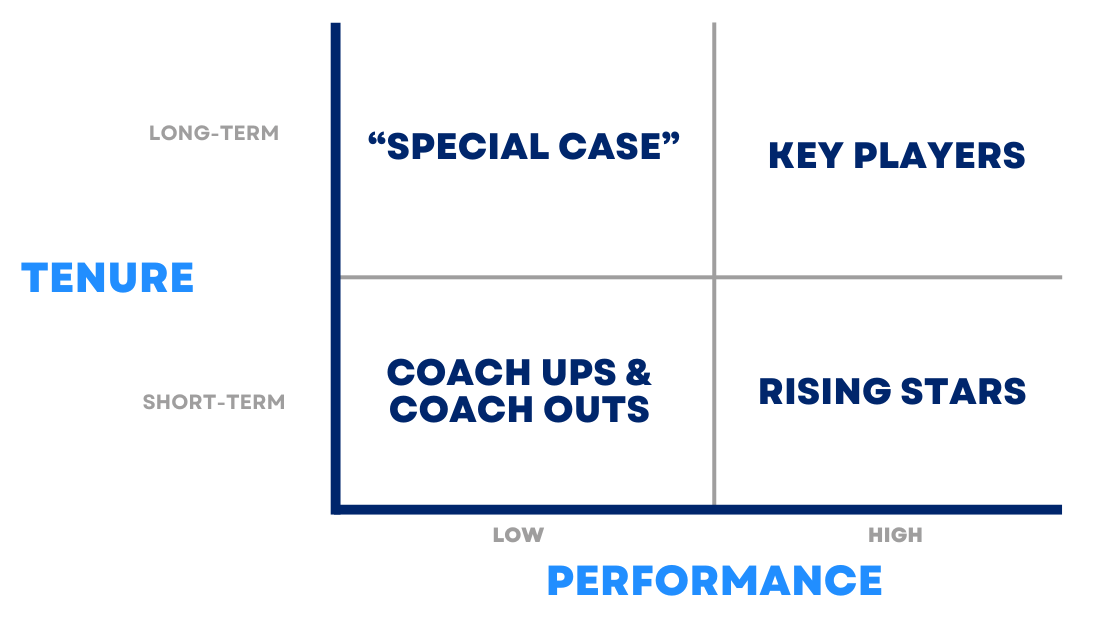What’s the Problem?
Think about each of your team members in two ways: how long they’ve been with you and how well they perform. That framework reveals four kinds of employees. Take a look:

Long-term, high-performing employees are your key players. New, high-performing employees are your rising stars. These two are every manager’s favorites, for obvious reasons.
New, low-performing employees can either be coached up (taught the skills and behaviors necessary to become a key player) or coached out (assisted in understanding their strengths and finding alternative employment).
The real struggle is in that upper left corner – your long-term, low-performing employees. Your “special cases.” Herein lies the loyalty dilemma.
There are a few reasons why an employee might end up in this corner. As your industry is evolving, hopefully your business is, too. Your business’ needs and culture are changing, and not everyone is able to change with them. Any given employee’s job description or required skillset may be different today than it was yesterday, and some will fall out of step with company standards over time.
These frictions may be exacerbated by an employee’s resistance to adaptation. In the face of change, many people adopt fixed mindsets or develop fears of what lies ahead. If they don’t experience any consequences for their resistance, they will be encouraged to continue resisting. This often manifests as excuse-making, blaming of peers or circumstances, and a general lack of ownership for shortcomings. All evidence suggests that this employee is no longer a fit for your business.
Here’s the catch: you’re feeling guilty. Perhaps this employee has been around since the beginning. Perhaps they used to be a key player. Struggling with this situation means you are a loyal manager, which is honorable! But the emotions that are inherently tied to loyalty are often at odds with good judgment. This is the loyalty dilemma.
How Do People Handle It?
Unfortunately, most managers think they can find a way around the loyalty dilemma without addressing it head-on.
Some managers simply tolerate poor performance and accept unacceptable behavior. This approach fails everybody; morale takes a major blow when other employees notice that somebody isn’t carrying their weight and you aren’t doing anything about it. If your low-performing employee works directly with clients, your customers will be left frustrated. A general sense of friction will develop in your business operations.
The fact is, you get the behavior you tolerate.
Tolerating or turning a blind eye to poor performance often ends dramatically: your employee is left unchecked for so long that a major client finally abandons your business. Or, a frustrated key player walks out.
Some owners make half-hearted attempts to change the employee’s behavior. An attempt to coach up is noble, but if subsequent expectations and consequences aren’t upheld, you are only creating a cycle of frustration. Unfortunately, it’s not enough to say that you “tried” in this situation.
And some create new rules for their long-term employees, babysitting them or creating extra work to keep them looking busy without allowing them to negatively impact business. This may seem like an easy fix, but in reality, you are only creating a financial drag and showing your team that you permit unwarranted preferential treatment.
While these approaches are understandable, and likely guided by your moral compass, they also signal poor judgment, inequitable treatment of your employees, and lack of a growth mindset amongst management.
What is the Path to Success?
Be warned: the correct approach to this issue will not remove discomfort. The steps to a successful resolution will be difficult, but they will yield a much-improved business operation and culture.
In order to fairly evaluate the problem at hand, you need to ask yourself a few questions:
- Is any singular person’s continued employment more important than the success – or even survival – of the whole company?
- What is the cost of inaction in this situation? How will frustration grow and manifest? Which clients will eventually leave? Which employees will walk out?
- What are the consequences of replacing this person? How difficult will it really be? Is the fear greater than the reality of restructuring?
- What do you owe to the rest of your team? As a leader, what is your responsibility to them and their morale?
- Are you acting with integrity? Are you being honest with yourself about the principles you are upholding when making any given decision related to this problem?
Once you clarify your mindset, try to subtract your emotions. As honorable as they are, they cloud your objectivity as a manager.
At this point, it is key to be fair with your employees. Offer them a real opportunity to improve their skills and behaviors. In doing so, understand that you are responsible for being clear about your expectations and what your employee needs to do in order to meet them. Nobody can read your mind, and clarity is just as respectable as loyalty.
If you continue to experience frustration with the employee, the best way you can express your loyalty to them is to be humane in letting them go. If your needs, expectations, and skills are no longer aligned, they will be better off employed elsewhere. Being humane involves more than having a difficult conversation; offer your employee an orderly transition out by giving them the time and assistance they may need in order to find new work.
Letting an employee go is never easy, and letting a long-term employee go may feel like a breach of ethics. But the difficult truth is that holding onto an ineffective team member is a disservice to that employee, to the rest of your team, to yourself as a manager, and to your business as a whole.
Loyalty can take many forms. Do not risk your credibility as a manager by chasing a false sense of honor. Instead, show your team that you can be objective, fair, and humane in the face of adversity.
